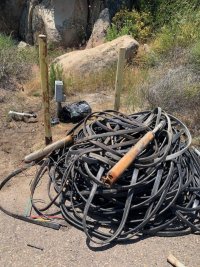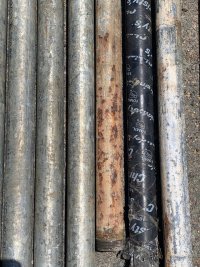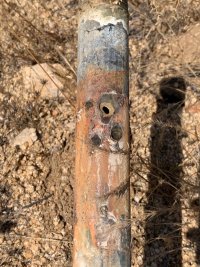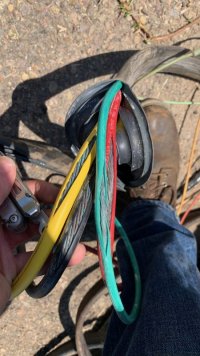tdcody
New Member
Hello all - long time lurker - I have learned a lot about scenarios somewhat different than my own and would greatly appreciate any guidance this community can provide.
I am the new owner of a water well-supplied home in San Diego County - very high wildfire risk, so we have the required 10,000 gal galvanized storage tank which serves the home (including automatic fire sprinklers), large irrigation system, and fire hydrant. This is my first experience with a well!
Well info (all specs from original driller report): drilled 2003, 900' deep, depth to 1st water 675', static water level 380', 20' of 6.5" steel casing, then remainder 4" PVC casing (alternating screen/solid) to the bottom. Original production was 29gpm in 2003, currently 13gpm.
The well most recently (until this morning) housed a 2008-model year submersible 5hp 10gpm single phase motor/pump, piped uphill about 200' vertical rise to the 10,000 gal storage tank, with adjacent pumphouse. In pump house is a very large booster pump (also 5hp) charging two ~80gal expansion tanks, which then supply the house (including automatic fire sprinklers) and irrigation circuits. The fire hydrant is connected directly to the storage tank with a large-bore pipe. Aside from the well pump's integral check valve, there is another check valve at the top of the well (horizontal) and a third at the base of the storage tank at ground level just before the fill pipe climbs up to the top of the tank. Both inline check valves were replaced a few months ago after water hammer (I think) caused the PVC pipe to break just past the well and that first inline check valve. There is evidence of prior repairs to the pipe at that location.
Well pump stopped running and was found to be drawing very high current (up to 80A, intermittently tripping overload), so frozen pump was suspected. It was pulled today (very cool to watch!) with the following findings:
1) pump not locked, but has intermittently significant resistance to turn by hand.
2) several sections of galvanized drop pipe were corroded substantially, one with several small penetrations.
3) 2/3 flat submersible cable had water inside the outer insulation sleeve and also within the individual wire's insulation, with surface oxidation of the stranded copper wire inside - all four wires affected through at least the bottom 25', after which I didn't cut it open further.
Well company (new to me) is proposing install of the following:
Pump: 10GS50 Goulds 10GPM 5HP 42 stage 4" pump ($3200)
Motor: M50432 Goulds CentriPro 4", 5 HP, 230 Volts, 3 Phase motor ($2300)
Driver: 136X1213 Danfoss VLT Aqua-Drive 7.5HP/5.5kW 230V single phase driver ($4900)
Cable: 4/3 flat submersible cable, 870' ($10,100)
Drop pipe: replace six corroded galvanized pipe sections with Sch 120 PVC ($1030 material cost)
+ labor (pull old stuff, install new stuff)
+ supplies
Total: ~$24,500
1 year labor warranty, 3 year manufacturer warranty on pump/motor, shorter warranty on the driver.
Company states expected life of the well motor/pump is 5-10 years.
Short-term goal: restore the system's functionality and future-proof as much as is reasonably possible in terms of well components, including trying to get more life out of the down-hole hardware than 5-10 years, which seems like it should be possible. I am shelving the booster pump/pressure tank setup for now, which I plan to overhaul and redesign in the next 8-12 months (unless it fails sooner).
I have many questions! I will limit myself to the major ones:
1) is this a reasonable setup in general?
2) I am unsure how to weigh the pros/cons of the recommended VFD upgrade given the giant unpressurized storage tank upstream of the booster and pressure tanks, and therefore much less benefit for constant pressure supply from the well pump. I see the benefit in a VFD setup for a new booster pump.
3) am I in the right ballpark with 5hp/10gpm submersible pump size to begin with?
4) is the water intrusion/corrosion of the submersible wire a common problem, or a fluke due to some kind of old amateur mistake that is not likely to be repeated with professional work?
5) Cost!! I understand that most of these components are priced at close to or over 2x retail cost elsewhere. The wire/cable pricing is particularly hard to swallow. Labor looks underpriced, comparatively. They do not want to install anything they aren't providing. I understand the need to build costs and profit into materials, but this seems a bit insane. Plus I don't see much insurance with the 1 year labor warranty. I want to be fair but not get scammed.
Thank you in advance for any advice. I cannot contribute expert well/plumbing info, but I can offer veterinary info for those of you with furry friends.
Sincerely,
Dave
I am the new owner of a water well-supplied home in San Diego County - very high wildfire risk, so we have the required 10,000 gal galvanized storage tank which serves the home (including automatic fire sprinklers), large irrigation system, and fire hydrant. This is my first experience with a well!
Well info (all specs from original driller report): drilled 2003, 900' deep, depth to 1st water 675', static water level 380', 20' of 6.5" steel casing, then remainder 4" PVC casing (alternating screen/solid) to the bottom. Original production was 29gpm in 2003, currently 13gpm.
The well most recently (until this morning) housed a 2008-model year submersible 5hp 10gpm single phase motor/pump, piped uphill about 200' vertical rise to the 10,000 gal storage tank, with adjacent pumphouse. In pump house is a very large booster pump (also 5hp) charging two ~80gal expansion tanks, which then supply the house (including automatic fire sprinklers) and irrigation circuits. The fire hydrant is connected directly to the storage tank with a large-bore pipe. Aside from the well pump's integral check valve, there is another check valve at the top of the well (horizontal) and a third at the base of the storage tank at ground level just before the fill pipe climbs up to the top of the tank. Both inline check valves were replaced a few months ago after water hammer (I think) caused the PVC pipe to break just past the well and that first inline check valve. There is evidence of prior repairs to the pipe at that location.
Well pump stopped running and was found to be drawing very high current (up to 80A, intermittently tripping overload), so frozen pump was suspected. It was pulled today (very cool to watch!) with the following findings:
1) pump not locked, but has intermittently significant resistance to turn by hand.
2) several sections of galvanized drop pipe were corroded substantially, one with several small penetrations.
3) 2/3 flat submersible cable had water inside the outer insulation sleeve and also within the individual wire's insulation, with surface oxidation of the stranded copper wire inside - all four wires affected through at least the bottom 25', after which I didn't cut it open further.
Well company (new to me) is proposing install of the following:
Pump: 10GS50 Goulds 10GPM 5HP 42 stage 4" pump ($3200)
Motor: M50432 Goulds CentriPro 4", 5 HP, 230 Volts, 3 Phase motor ($2300)
Driver: 136X1213 Danfoss VLT Aqua-Drive 7.5HP/5.5kW 230V single phase driver ($4900)
Cable: 4/3 flat submersible cable, 870' ($10,100)
Drop pipe: replace six corroded galvanized pipe sections with Sch 120 PVC ($1030 material cost)
+ labor (pull old stuff, install new stuff)
+ supplies
Total: ~$24,500
1 year labor warranty, 3 year manufacturer warranty on pump/motor, shorter warranty on the driver.
Company states expected life of the well motor/pump is 5-10 years.
Short-term goal: restore the system's functionality and future-proof as much as is reasonably possible in terms of well components, including trying to get more life out of the down-hole hardware than 5-10 years, which seems like it should be possible. I am shelving the booster pump/pressure tank setup for now, which I plan to overhaul and redesign in the next 8-12 months (unless it fails sooner).
I have many questions! I will limit myself to the major ones:
1) is this a reasonable setup in general?
2) I am unsure how to weigh the pros/cons of the recommended VFD upgrade given the giant unpressurized storage tank upstream of the booster and pressure tanks, and therefore much less benefit for constant pressure supply from the well pump. I see the benefit in a VFD setup for a new booster pump.
3) am I in the right ballpark with 5hp/10gpm submersible pump size to begin with?
4) is the water intrusion/corrosion of the submersible wire a common problem, or a fluke due to some kind of old amateur mistake that is not likely to be repeated with professional work?
5) Cost!! I understand that most of these components are priced at close to or over 2x retail cost elsewhere. The wire/cable pricing is particularly hard to swallow. Labor looks underpriced, comparatively. They do not want to install anything they aren't providing. I understand the need to build costs and profit into materials, but this seems a bit insane. Plus I don't see much insurance with the 1 year labor warranty. I want to be fair but not get scammed.
Thank you in advance for any advice. I cannot contribute expert well/plumbing info, but I can offer veterinary info for those of you with furry friends.
Sincerely,
Dave




